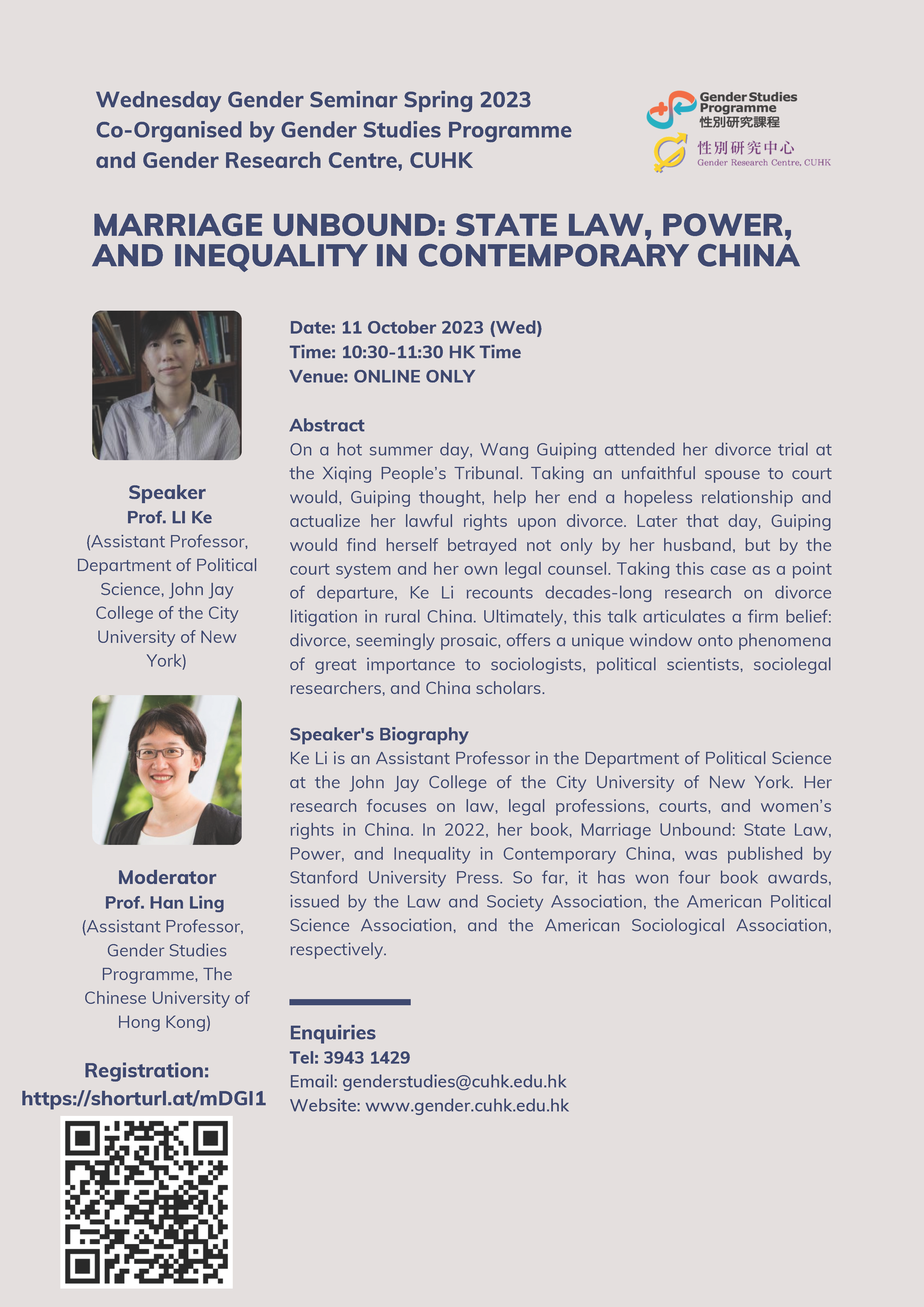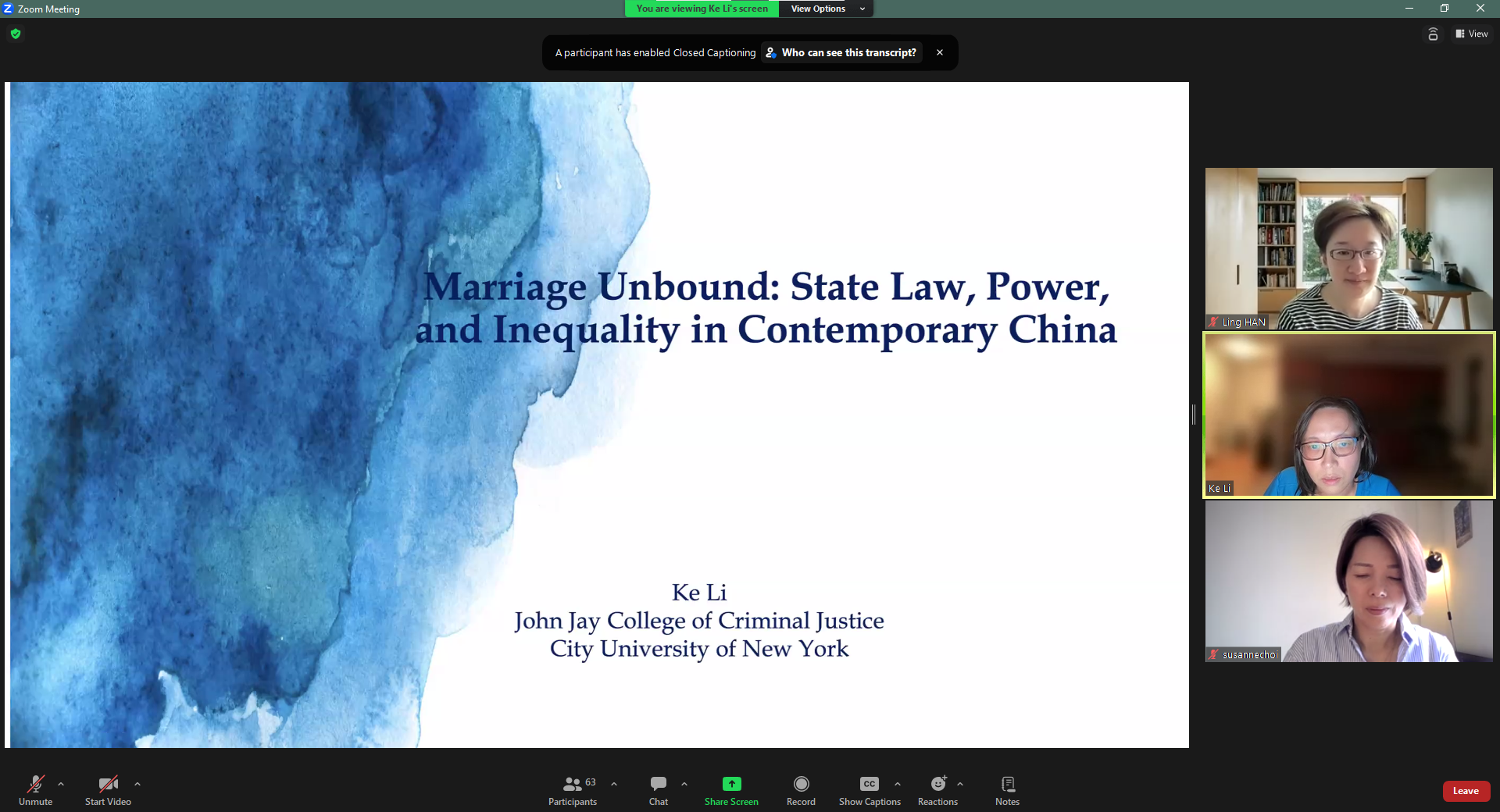The book Marriage Unbound: State Law, Power, and Inequality in Contemporary China by Li Ke documents rural women’s experience of pursuing divorce in the court. From the women who struggled in strained marriage, Li Ke reveals the gender unequal marriage in society, politics, and power perspectives.
In the society perspective, with the deepening of the urbanization process and the large urban-rural population movement, the marriages of farmers are deeply affected. Women they also need psychological value from partners rather than the property, which is the only criterion for men.
In the politics perspective, Li Ke discover how did the state withdraw from the private lives of citizens, intervene in citizens’ intimate lives by shifting from political campaigns to judicial means. The governing methodologies changes has gone through three phases of change. In the Maoist era, the dominant mode of state intervention was mass campaigns. From 1977 to late 1990s, mass campaigns gave way to people’s mediation. And nowadays, The courts have become the main forum for the resolution of litigation and the defense of the institution of marriage. Multipronged system, comprising litigation, people’s mediation, letters and visit, and other official measures have also become more important. It makes the private marriage controlled by the government.
In the power perspective, dispute resolution can be interpreted in terms of interconnected power relations. It includes three ways. First, formal decision-making power means that judges have their power to determines who prevails over the conflicts. Secondly, agenda-setting power delimits the scope of entering formal judicial deliberations. In Li Ke’s research, she discovered that the divorce approval rate have been decreased yearly. Thirdly, consciousness-formation power is acted by ideological indoctrination, acculturation, and other cultural processes. The power subject instills consent and compliance in disempowered groups, leaving rights contention not only unactionable, but unthinkable. All of these aspects happen surrounding us in
China. And the function of power exacerbates gender inequality.
Li Ke’s description of the unequal marriages of rural women has given me a deeper understanding of the current situation in the contemporary countryside, the political and legal constraints and inequalities of divorce. It taught me not only about the phenomenon itself, but also about the methodology from a sociological perspective. It makes me how to conduct interdisciplinary research and to think more comprehensively when considering issues from the gender perspective. Overall, I would like to pay more attention to the gender inequality of specific groups and take them in detail in the future studies
Written by: LIU, Moxuan
Today’s topic focuses on sharing the content and structure of the book: Marriage Unbound: State Law, Power, and Inequality in Contemporary China. In the book, the author analyses state law, power, and inequality in contemporary China by focusing on women’s divorce cases and several prominent scenarios therein. In the Presentation, the author first introduces the case of Wang Guiping’s unsuccessful lawsuit against her cheating husband, and then explains the structure of the book,and the structure of the book is described and analysed by the author in the following three parts.
In the first part, the link between labour migration and marital instability, the book takes a very nuanced look at how the massive growth of the urban population over the decades has reshaped families and marriages in China. The author illustrates the dramatic rise in China’s divorce rate in recent decades with a chart depicting the increase in both the number of marriages dissolved by the courts and the number of divorces granted by the local government. And then the author uses a couple’s experience to reveal how labour migration complicates the intimate lives of ordinary women and men and often leads to marital dissatisfaction and even divorce. It is mentioned that in the second chapter of the book, the intricate links between labour, migration and marital instability are detailed.
In the second part of the interplay of law and politics in authoritarian state, the author explains, by taking into account the historical trajectory of the Chinese revolution, that the mass movement gave way to people’s mediation, and the PRC increasingly relied on litigation to intervene in people’s marital affairs, but this behaviour cannot be seen as a shift of the authoritarian regime towards the law, but rather the ruling class strategically tap into diverse cultural traditions, Such traditions include, but not limited to the country’s real or imagined routes in Confucianism, the Maoist past, socialist legacies and foreign influences, including influences from liberal democracies, by weaving legality and extra legality into its ruling by mobilisation. Issues related to the development of Chinese law are further elaborated in Chapters 3 and 4 of the book.
In the third section on power, and inequality within and outside the courts in China, the authors raise the issue of inequality in family litigation and propose a power-centred framework that includes two types of power, the first being power relations, which the authors refer to as formal decision making power, and which refers to the type of power that determines who has the upper hand in resolving public conflicts and divorce proceedings. The second refers to agenda-setting power, which is the type of power relationship that limits the scope of official decision-making by excluding certain issues or certain participants from formal deliberations. The authors also illustrate the increasing rate of withdrawal of divorce proceedings through data and point out that it is explained in detail in chapter 5 of the book.
The author concludes by suggesting that by collaborating with colleagues from multiple disciplines, she hopes the book will allow readers to see the complex relationship between authority, internal rules, legal institutions, social inequality, and, of course, power relations.
In the Q&A part, the authors answer the question of whether female judges do not tend to provide more favourable outcomes for female litigants in litigation cases due to the same institutional environment, regardless of gender identity, from the point of view of social structure and social hierarchy. And from an ideological point of view, such as the political significance in the party space, ruling methodology and the idea that family explains why the state should intervene in the intimate relationships of citizens, such as the establishment of a cooling-off period from the legal point of view in order to reduce the rate of divorce from a macro point of view.
Written by: PENG, Xiaoya
Ke Li unfolded her talk along three lines. First, the linkage between labor migration and marital instability. Second, the interplay of law and politics in authoritarian state. Third power and inequality within and outside chinese courts.
First, Li discussed how rural women’s participation in labor migration has reshaped chinese family and and marriage. In her perspectives, rural women’s participation in the urban workforce extends their day to day interactions with men outside the home. In that sense, labor migration offers women not only the opportunity of financial independence, but fresh opportunity to reimagine and rearrange their intimate relationships. In addition, as women embark on labor migration, the traditional pattern of division of labor in the family is under attack. Many men show anxiety, jealousy, anger and even violence towards their wives, which hurts their relationship.
Then, Li discussed the evolving legal and dispute resolutionsystems in the PRC, emphasizing the regime’s approach to governing and adapting. She pointed that the PRC has cultivated in multiple system for dispute management. Rather than hanging on one methodology: judicial or extrajudicial, the PRC has imbricated the two as part and parcel of its governing tool kit.This flexible approach helps them adapt to new challenges. However, it can sometimes lead to unexpected issues or consequences.
Third, Li discussed her research and findings related to power dynamics and gender inequality in the Chinese legal system, particularly in divorce cases. Li started by highlighting Wang Huiping ‘s case. Wang had to give up her property rights while her husband faced minimal legal consequences for his actions, including domestic violence and cohabiting with another woman. However, this is a very common situation. Li conducted research on 198 divorce lawsuits and found that, in the grassroots court system, women often fared worse than men.
To better understand these gender inequalities in the legal system, Li proposed a “power-centered framework”. This framework includes three types of power relationships:
1. Formal decision-making power: Judges usually sided with husbands as opposed to wives in divorce cases, leading to women losing property and rights.
2. Agenda-setting power: This type of power determines which issues or topics can be discussed in the legal process. Li presented a figure which showed that Chinese judges have increasingly applied withdraw as a mode to dispose of divorce lawsuits at the beginning of this time period in 1974. In addition, lawyers often focus on property division and child custody while overlooking or ignoring complaints of domestic violence.
3. Conscious formation power: Power holders shape women’s beliefs and expectations through ideological indoctrination and cultural processes. Therefore women often remain silent on their lawful entitlement to land holding.
Therefore, when these three power relationships work against women, gender inequality deepens during dispute resolution, despite decades of legal reforms in China.
In conclusion, the author suggests that looking at divorce through this conceptual lens can provide insights for sociologists, political scientists, social legal researchers, and China scholars. The book aims to allow readers to see the complex relations among authoritarian rule, legal institutions, social inequality, and power relationships.
Written by: QIN, Kaixin
In this week’s seminar, Prof. Li provided us with a thorough overview of how widespread migration from rural to urban regions has changed families, marriages, and gender relations in China with the support of real-world examples.
Prof. Li begins by explaining the connection between labor mobility and unstable marriages. With the reform of agriculture, the influx of foreign investment, the development of the service economy, and the relaxation of national policies, more and more rural women have begun to migrate to the cities, mainly to work in labor-intensive industries. In addition to offering women the much-needed financial independence, labor migration poses an unprecedented threat to marriages shaped by traditional patriarchy. In the case of Yuan Yue, a migrant worker, her work outside the village triggered distrust and suspicion from her husband, and when suspicion and accusation evolved into ridicule, humiliation, and emotional and physical abuse, their marriage would come to an end.
Then, we look into the interaction of law and politics in Authoritarian States. From the mass movements of the Maoist era to the people’s mediation of the socialist period to today’s multipronged system, marital disputes rely more on the judiciary. However, such judicial solutions have serious limitations and pitfalls. Women from rural areas often end up losing most of their rights as wives, mothers, property owners and land users.
At last, Prof. Li uses divorce proceedings as a window, showing us how three different types of power operate – agenda-setting power, consciousness-formation power, and formal decision-making power – all of which entrench institutional practices within the courts and in the surrounding rural communities. When all three types of power work against women, gender inequality inevitably emerges and deepens in the dispute resolution process. Ultimately, rather than being a weapon for the weak, legal mobilization and litigation exacerbate and reproduce inequalities between ordinary men and women.
To conclude, this seminar provided me with an understanding of the processes, mechanisms and power dynamics that affect women’s experience of disputes and litigation within and outside of the courts – women’s rights are often not upheld by the regional government, the legal profession, or the justice system.
Written by: SHAO, Tianhua
On last Wednesday’s gender seminar, Li shared some intriguing cases and key findings from her book Marriage Unbound: State Law, Power, and Inequality in Contemporary China published by Stanford Press. In her talk, she started from introducing the divorcing case of Wang Guiping, a female migrant worker who came to urban area to make a living and thus lived away from her husband in their rural home. Li argued that urban lives often empower these migrant women with the opportunities to build new social connections and more space to explore different forms of intimate relationships that could hardly exist in rural China. Based on Wang Guiping’s and other rural women’s case, Li explained why increasingly more rural migrant women want to get out of unhappy marriages. She provided a detailed account of several rural women’s marital life and how their participation in labor migration causes marital tensions and extramarital affairs. Drawing on these women similar experience, Li was trying to unpack the complex relationship between labor migration and marital instability in China, particularly within rural communities. The employment of rural women in urban environments not only fosters economic self-reliance but also engenders aspirations for financial stability, personal liberty, emotional fulfillment, and a redefined intimate relationship that satisfies these aspirations.
After introducing the emerging pattern among rural women who seek for divorce, Li gave us a brief overview about how the state had used different methods to intervene in marital disputes according to its goals in different historical periods. She argued that people’s private lives in PRC were always highly intertwined with the state’s power, where the insiders of the judicial system including legislators, judges, and government officials impose their power on marital dispute resolution to achieve the state’s goal (building a harmonious socialist society). However, women’s right for child custody, property, and landholding were often sacrificed or ignored under judicial insiders’ manipulation of decision.
In conclusion, Li’s findings revealed that principle of gender equality, although enshrined in law, is seldom fully actualized or granted priority for realization. Similarly, the freedom pertaining to marriage and divorce, as guaranteed by law, are also susceptible to failure when confronted with power dynamics. It highlights the complex and nuanced interactions between legal provisions and their practical implementation, particularly in the context of gender relations and marital rights.
Written by: TU, Lingyan





A
A
A
Contact Us